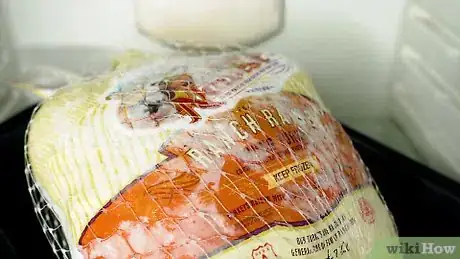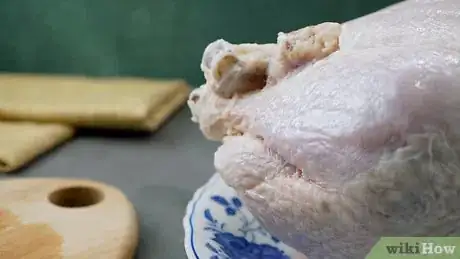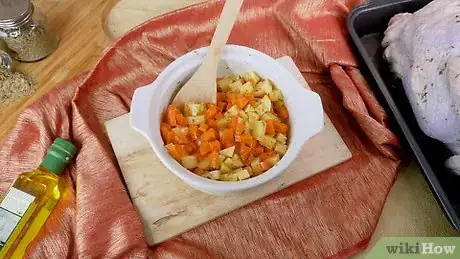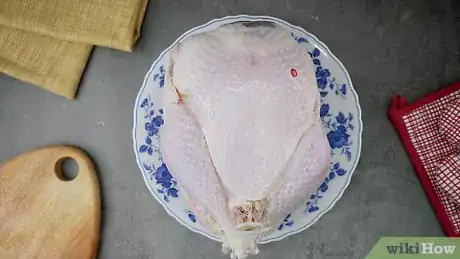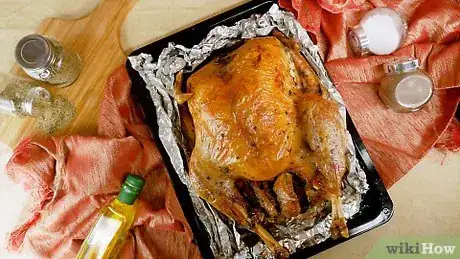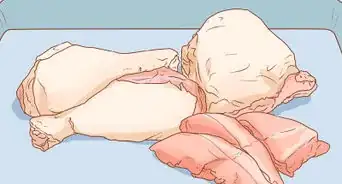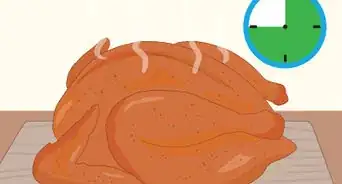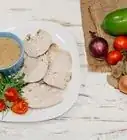This article was co-authored by Ollie George Cigliano and by wikiHow staff writer, Janice Tieperman. Ollie George Cigliano is a Private Chef, Food Educator, and Owner of Ollie George Cooks, based in Long Beach, California. With over 20 years of experience, she specializes in utilizing fresh, fun ingredients and mixing traditional and innovative cooking techniques. Ollie George holds a BA in Comparative Literature from The University of California, Berkeley, and a Nutrition and Healthy Living Certificate from eCornell University.
There are 11 references cited in this article, which can be found at the bottom of the page.
This article has been viewed 54,103 times.
Are you in charge of cooking the turkey this year at your Thanksgiving or Friendsgiving feast? If so, you’ve come to the right place. We’ve put together an easy, simple, and foolproof turkey recipe that doesn’t require any special techniques like brining, stuffing, and basting. Keep reading for step-by-step guidance on how to both prepare and roast a decadent, juicy bird that your dinner guests will rave about!
Ingredients
- Whole turkey (any size)
- Salt
- Pepper
- Fresh herbs
- Butter or oil
- Fresh veggies (optional)
Steps
Prepping
-
1Thaw out your bird in the refrigerator several days before Thanksgiving. Your turkey needs plenty of time to defrost evenly before spending any quality time in the oven. If your turkey thaws unevenly, it’ll cook unevenly too—and no one wants that![1] The total thawing time ultimately depends on how big your bird is. Here’s a handy defrosting guide to help you get started:[2]
- 4 to 12 lb (1.8 to 5.4 kg): 1-3 days of total thawing time
- 12 to 16 lb (5.4 to 7.3 kg): 3-4 days of total thawing time
- 16 to 20 lb (7.3 to 9.1 kg): 4-5 days of total thawing time
- 20 to 24 lb (9.1 to 10.9 kg): 5-6 days of total thawing time
-
2Defrost your turkey in cold water if you’re short on time. There’s no need to panic if your turkey is still in the freezer on Thanksgiving day. Just fill up a sink or basin with cold water and submerge your turkey in the bath. Try to drain and replace the water once every half hour, so the bath stays nice and cold. Here’s a thawing guide for different turkey sizes:[3]
- 4 to 12 lb (1.8 to 5.4 kg): 2 to 6 hours of thawing time
- 12 to 16 lb (5.4 to 7.3 kg): 6 to 8 hours of thawing time
- 16 to 20 lb (7.3 to 9.1 kg): 8 to 10 hours of thawing time
- 20 to 24 lb (9.1 to 10.9 kg): 10 to 12 hours of thawing time
Advertisement -
3Take your turkey out of the fridge around an hour before your scheduled cook time. Sticking a refrigerator-temperature bird directly in the oven isn’t a great idea, since a cold bird may not cook as evenly. Instead, set the defrosted turkey on top of the roasting rack in your roasting pan along a countertop or table so the meat can adjust to room temperature.[4]
- If you don’t have a roasting pan, place your roasting rack on top of a big sheet pan instead.
- Skip this step if you thawed your turkey in a cool water bath. In this case, start cooking your bird as soon as it defrosts all the way.[5]
-
4Pull out the giblets and neck from the inside of the turkey. “Giblets” is actually an umbrella term for the turkey’s heart, gizzard, and neck—these tend to be small and lump-shaped, and are often pre-packaged in a bag by the manufacturer.[6] Then, pull out the turkey neck, which is long, curved, and almost shrimp-shaped.[7]
- As gross as this is, you do need to remove the neck and giblets before you can start cooking the turkey. Thankfully, you can get it over with pretty early on!
- Some chefs like to set aside the turkey neck, heart, and gizzard for the gravy. They often throw out the dark red, lumpy turkey liver, which can add a bitter flavor to the sauce.[8]
-
5Preheat your oven to 350 °F (177 °C). Some Thanksgiving turkey recipes require you to frequently adjust the oven temperature, but you don’t have to worry about that here. Just preheat your oven to 350 °F (177 °C) about 15 minutes before you plan to but the bird in and forget about it—you won’t have to adjust the settings whatsoever![9]
-
6Season the inside and outside of your bird with both salt and pepper. Mix at least 4.5 tsp (27 g) of kosher salt and 1.5 tbsp (10.35 g) of ground black pepper together in a small bowl for a 12 to 14 lb (5.4 to 6.4 kg) bird. Then, spread the seasoning mixture all over the outside of the bird, including the legs. While you’re at it, season the cavity of the turkey with the salt and pepper mixture as well.[10]
- Cooking pros suggest using around ⅛ tsp (2.13 g) of salt and 0.4 tsp (2.3 g) of pepper per 1 lb (0.45 kg) of meat.
- Go ahead and skip the seasoning if you’re working with a kosher-style bird, which comes pre-seasoned. You also don’t need to season a turkey that’s already brined.
-
7Fill your turkey with herbs, fruits, and/or veggies instead of traditional stuffing. Cooking stuffing inside of your turkey isn’t a great idea—because of the extra filling, you’ll have to roast the bird for longer, which can lead to dry, overcooked meat. Instead, stick a few sprigs of fresh herbs into the center of your turkey, along with your celery sticks or pieces of onion. These ingredients can add some great flavor without amping up the cooking time.[11]
- Thyme, rosemary, and parsley are all great herbs to put inside your turkey.
- Cooking experts don’t suggest an exact amount of herbs or veggies to stick inside of your turkey. It ultimately depends on the size of your bird!
-
8Rub oil or butter along the outside of your turkey to keep it juicy while it cooks. Measure out around 1/2 tbsp (7 g) of butter or oil per pound (0.45 kg) of turkey meat you have. Slather the butter or oil all over your turkey, so your bird cooks to golden-brown perfection in the oven.[12]
- You’re welcome to spread the butter/oil by hand or with a kitchen brush (if you’d prefer not to touch the raw meat directly).
- Make your turkey even juicier by sliding some butter or oil underneath the turkey breast skin.
Roasting
-
1Tie the turkey's legs together and tuck in both wings. To truss your turkey, slide the tapered tips of the wings behind the turkey’s shoulders, so they don’t get burnt in the oven. Then, cross the turkey legs over each other in an “X” shape and knot them together with a length of kitchen twine or unwaxed dental floss. Your turkey is ready to go![13]
- Some Thanksgiving turkeys may come packaged with a plastic or metal “hock lock”, which automatically secures the turkey’s legs together. Don’t worry about tying up your turkey if it already has this contraption.
-
2Add 2 c (470 mL) of water to the bottom of your roasting pan. As your turkey roasts, its drippings will start to fall to the bottom of the roasting pan. The cold water prevents these drippings from scorching during the cooking process.[14]
- Feel free to add some chopped-up veggies to the bottom of the roasting pan as well, like carrots, shallots, and/or celery. These help add a little extra flavor to the turkey drippings and meat.
-
3Arrange the turkey on top of the roasting rack with the breast meat facing up. Check that the turkey legs are pointing up and that the breast meat is facing the top of the oven. [15]
-
4Cover the turkey with a sheet of aluminum foil until it's half-cooked. Your turkey has to spend a good chunk of time in the oven before it’s ready to eat. A sheet of aluminum foil keeps the turkey’s skin covered up, so it doesn’t get burnt during the cooking process. Once the bird is half-cooked, remove the foil so the skin can get nice and golden brown.[16]
-
5Cook your turkey for 13 minutes for every 1 lb (0.45 kg) of meat. A small-to-medium-sized turkey won’t take more than a couple of hours to cook, while a larger bird may need a good portion of the day to roast.[17] Here’s some suggested cooking times for your reference:[18]
- 8 to 12 lb (3.6 to 5.4 kg): 2.75 to 3 hours of cooking time
- 12 to 14 lb (5.4 to 6.4 kg): 3 to 3.75 hours of cooking time
- 14 to 18 lb (6.4 to 8.2 kg): 3.75 to 4.25 hours of cooking time
- 18 to 20 lb (8.2 to 9.1 kg): 4.25 to 4.5 hours of cooking time
- 20 to 24 lb (9.1 to 10.9 kg): 4.5 to 5 hours of cooking time
-
6Check that your turkey is at least 165 °F (74 °C) on the inside. After the initial oven timer goes off, stick your meat thermometer into the thigh, the inside section of the wing, and the deepest portion of the chicken breast. Make sure that the thermometer reads 165 °F (74 °C) before taking the turkey out of the oven.[19]
- The deepest portion of the chicken breast is along the bottom of the turkey, directly opposite of the legs.[20]
-
7Wait 20 minutes before you carve and serve the turkey. Believe it or not, 20 minutes can make the difference between a juicy turkey and a dry one. After you pull it out of the oven, the turkey needs time to reabsorb all of its savory, delicious juices. If you cut into the turkey right away, the juice will drip out of the bird and the meat will be dry.[21]
Expert Q&A
-
QuestionIs it better to dry brine or wet brine a turkey?
 Ollie George CiglianoOllie George Cigliano is a Private Chef, Food Educator, and Owner of Ollie George Cooks, based in Long Beach, California. With over 20 years of experience, she specializes in utilizing fresh, fun ingredients and mixing traditional and innovative cooking techniques. Ollie George holds a BA in Comparative Literature from The University of California, Berkeley, and a Nutrition and Healthy Living Certificate from eCornell University.
Ollie George CiglianoOllie George Cigliano is a Private Chef, Food Educator, and Owner of Ollie George Cooks, based in Long Beach, California. With over 20 years of experience, she specializes in utilizing fresh, fun ingredients and mixing traditional and innovative cooking techniques. Ollie George holds a BA in Comparative Literature from The University of California, Berkeley, and a Nutrition and Healthy Living Certificate from eCornell University.
Private Chef & Food Educator I usually prefer dry brining to wet brining. To make your brine, mix 3 tablespoons kosher salt, 1 ½ teaspoons fresh herbs — dry big sprigs of thyme, sage, and rosemary or get dried herbs at the grocery store — and ¾ teaspoon freshly ground black pepper in a small bowl.
I usually prefer dry brining to wet brining. To make your brine, mix 3 tablespoons kosher salt, 1 ½ teaspoons fresh herbs — dry big sprigs of thyme, sage, and rosemary or get dried herbs at the grocery store — and ¾ teaspoon freshly ground black pepper in a small bowl. -
QuestionIs it better to cook stuffing inside of the turkey?
 Ollie George CiglianoOllie George Cigliano is a Private Chef, Food Educator, and Owner of Ollie George Cooks, based in Long Beach, California. With over 20 years of experience, she specializes in utilizing fresh, fun ingredients and mixing traditional and innovative cooking techniques. Ollie George holds a BA in Comparative Literature from The University of California, Berkeley, and a Nutrition and Healthy Living Certificate from eCornell University.
Ollie George CiglianoOllie George Cigliano is a Private Chef, Food Educator, and Owner of Ollie George Cooks, based in Long Beach, California. With over 20 years of experience, she specializes in utilizing fresh, fun ingredients and mixing traditional and innovative cooking techniques. Ollie George holds a BA in Comparative Literature from The University of California, Berkeley, and a Nutrition and Healthy Living Certificate from eCornell University.
Private Chef & Food Educator If you are making stuffing or dressing, be sure to make it on the side and not in the cavity. Stuffing the bird with dressing can result in undercooking the inside of the bird, which can lead to illness like salmonella poisoning.
If you are making stuffing or dressing, be sure to make it on the side and not in the cavity. Stuffing the bird with dressing can result in undercooking the inside of the bird, which can lead to illness like salmonella poisoning. -
QuestionHow can I cook a turkey without an oven?
 Community AnswerYou can try deep frying your turkey, but you have to be careful!
Community AnswerYou can try deep frying your turkey, but you have to be careful!
Warnings
- Never rinse off your turkey with water before prepping and roasting it. Instead of removing the turkey bacteria, rinsing may actually spread the germs to other parts of your kitchen.[22]⧼thumbs_response⧽
Things You’ll Need
- Roasting pan
- Roasting rack
- Kitchen twine or unwaxed dental floss
- Aluminum foil
- Meat thermometer
References
- ↑ https://www.epicurious.com/holidays-events/how-to-thaw-turkey-fast-article
- ↑ https://www.foodsafety.gov/food-safety-charts/meat-poultry-charts
- ↑ https://www.foodsafety.gov/food-safety-charts/meat-poultry-charts
- ↑ https://www.epicurious.com/expert-advice/how-to-prep-a-turkey-for-thanksgiving-article
- ↑ https://www.foodsafety.gov/food-safety-charts/meat-poultry-charts
- ↑ https://www.youtube.com/watch?v=zXa8sSzsrII&t=0m15s
- ↑ https://www.youtube.com/watch?v=zXa8sSzsrII&t=0m27s
- ↑ https://www.cooksillustrated.com/how_tos/11678-turkey-giblets-what-to-keep-and-what-to-throw-away
- ↑ https://www.epicurious.com/expert-advice/how-to-prep-a-turkey-for-thanksgiving-article
- ↑ https://www.epicurious.com/expert-advice/how-to-prep-a-turkey-for-thanksgiving-article
- ↑ https://www.epicurious.com/expert-advice/how-to-prep-a-turkey-for-thanksgiving-article
- ↑ https://www.epicurious.com/expert-advice/how-to-prep-a-turkey-for-thanksgiving-article
- ↑ https://www.epicurious.com/expert-advice/how-to-truss-thanksgiving-turkey-easy-way-article
- ↑ https://www.epicurious.com/holidays-events/the-easiest-way-to-cook-turkey-article
- ↑ https://www.epicurious.com/expert-advice/how-to-prep-a-turkey-for-thanksgiving-article
- ↑ https://www.epicurious.com/holidays-events/the-easiest-way-to-cook-turkey-article
- ↑ https://www.epicurious.com/holidays-events/the-easiest-way-to-cook-turkey-article
- ↑ https://www.usda.gov/media/blog/2016/11/22/how-cook-thanksgiving-turkey
- ↑ https://www.usda.gov/media/blog/2016/11/22/how-cook-thanksgiving-turkey
- ↑ https://www.cooksillustrated.com/how_tos/10329-the-proper-way-to-use-a-probe
- ↑ https://www.epicurious.com/holidays-events/the-easiest-way-to-cook-turkey-article
- ↑ https://www.usda.gov/media/blog/2013/11/21/wash-or-not-wash-your-turkey
About This Article
Before you cook your Thanksgiving turkey, let it thaw in the fridge for 24 hours per every 5 pounds of turkey. If you're cooking a 10 pound turkey, for example, you'll need to thaw it for 48 hours. Make sure to avoid thawing at room temperature, which can cause bacteria to grow inside the meat. To get your turkey as juicy as possible, try brining it the night before in a solution of vegetable stock, brown sugar, and spices. In the morning, remove the turkey from the brine, and take out the neck and giblets. You can leave the cavity empty, or stuff it with aromatics, like apple slices and dried herbs, to keep the meat moist while adding extra flavor. For a crispy and golden-brown skin, baste the turkey with herb butter before placing it in a 475 degree Fahrenheit oven. After 20 minutes, reduce the temperature to 350 degrees Fahrenheit, and continue cooking the bird for 13 minutes per each pound of turkey. To learn more, like how to make gravy from the turkey drippings, read on!
